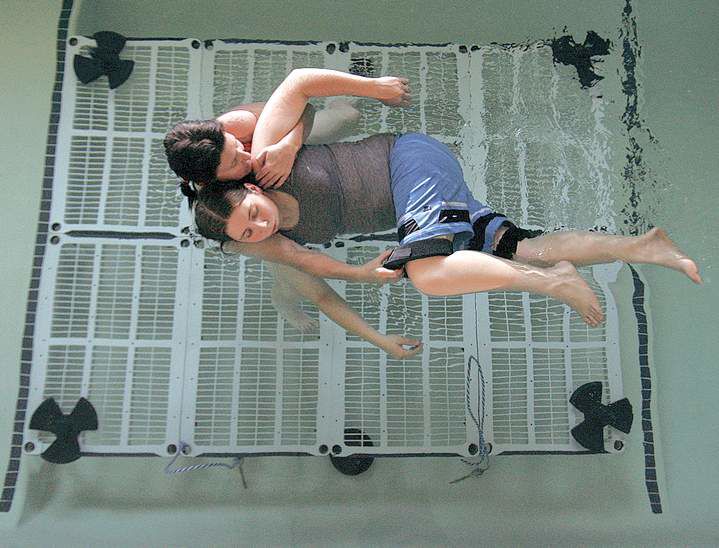Watsu therapy
Published 5:00 am Thursday, July 15, 2010

- Watsu provider Shoshana Foxwell, 45, pulls the knee of Megan Perry, 21, of Bend, toward her head during her second Watsu session in the pool at Rebound Physical Therapy's east-side location.
Gravity can wreak havoc on the body. The constant force pulls and tugs on joints and connective tissue, and requires the skeletal structure to support hundreds of pounds of weight. And as the body breaks down due to normal aging or injury, those forces can lead to chronic pain and limited mobility.
Imagine how good it would feel if you could turn off gravity for an hour or so, to float weightless, to literally take the load off your body.
Trending
That’s the concept behind Watsu, a form of aquatic therapy that uses the buoyancy and resistance of water to move creaky joints and relieve pain. Many people who have experienced Watsu call it the most relaxing experience they’ve ever encountered.
“It’s like a vacation in an hour,” said Shoshana Foxwell, who offers Watsu services at Rebound Physical Therapy’s west-Bend location.
Watsu — short for water shiatsu — was developed by massage therapist Howard Dull in the early 1980s. Dull had been studying Shiatsu massage techniques and began experimenting with using the massage techniques in a warm water pool.
He found that the support of water took the weight off the vertebrae and allowed him to move the spines of his clients in ways he couldn’t on dry land. Gentle, gradual twists and pulls relieve the pressure on the spine. He developed techniques that have gained in popularity both in massage and therapy settings.
In Watsu, the client is supported by the practitioner, assisted by various floats that can be attached to the legs, the midsection or under the head. For most of the session the individual lies on his or her back, head resting on the arm of the practitioner. The eyes, nose and mouth remain above water, but the ears are below, creating a quiet relaxing environment. The practitioner applies shiatsu pressure points to the face, head, torso and back, and stretches, bends and flexes the torso and limbs.
“You can gain so much more motion in the water,” Foxwell said. “Also, it’s like a 3-D table. I can get to places you can’t get to on land.”
Trending
In addition to holding the weight of the individual, the water provides gentle resistance against the skin and muscles, creating a massage-like effect. Because the water is warm — generally about 95 to 96 degrees — it helps relax muscles and joints, improves circulation and relieves pain.
“You like being in the hot tub? You like getting a massage? You’re getting both at the same time,” said Sunnie Phillips, a Watsu provider at Three Sisters Aquatics in Bend.
Watsu is often a viable alternative for chronic pain patients who can’t handle standard types of therapy or exercise. Pain often causes the muscles to become hypersensitive and to stiffen up to guard against pain. In the warm water, however, many find those muscles can relax, allowing the body to move freely.
“For the people with chronic pain, it feels so good because it’s so painful for them to move on land,” Foxwell said. “It gives them this sense of ‘Wow, I can really move’ because I’m moving them in such extreme positions once they get relaxed. It creates new mapping for their brain.”
Movements in the pool, she said, help to reinforce those pathways in the brain, allowing that person to regain some of that motion on land as well.
“It doesn’t matter where you learn to do that movement,” Foxwell explained. “It’s just that the body feels it can do that movement, so it loses the fear of doing that movement.”
It’s also been used extensively for patients with fibromyalgia and Parkinson’s disease. In the water, Foxwell can bend and twist the body to move various joints. She raises the individual up from below, stretching the spine, or pulls the body through the water by the head, creating side-to-side movement in the spine. She might pull a knee to the head or move a limb through its range of motion.
Watsu was recently evaluated in a study with 18 residents of a retirement community, all in their 70s or 80s. After 18 months of undergoing Watsu twice monthly, the seniors reported less pain and emotional stress, but increased flexibility and ability to relax. Eleven of the 16 seniors who reported less pain said the pain relief lasted for multiple days after their sessions.
Watsu has also gained popularity as a form of massage for people without health issues or for recreational and competitive athletes seeking to undo the stresses of training.
“Pregnant ladies love it,” Phillips said. “They can lay on their backs weightless, and their bodies can move.”
Many health insurance plans will cover Watsu when it is provided in a physical therapy setting, and some plans cover it as massage therapy. Otherwise, hour-long sessions run $60 to $100. Often it takes a session or two for clients to become relaxed enough for practitioners to move them through more complex motions.
“If there’s somebody who has a difficult time with relaxation,” Foxwell said, “if they have a safe space, I’ll tell them to go to that safe space, talk them through that. I’ll engage them with their breathing, so I kind of connect to where that person is at.”
Most of her clients will come for Watsu once or twice a week and usually complete the therapy after 12 sessions.
“People will usually notice a difference right way,” she said. “If they haven’t noticed a huge difference after two, three, four times, it’s probably not going to work for them.”








